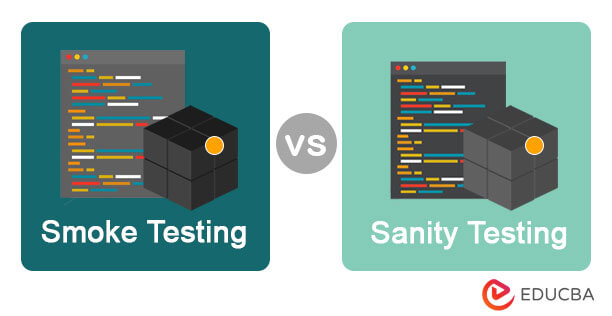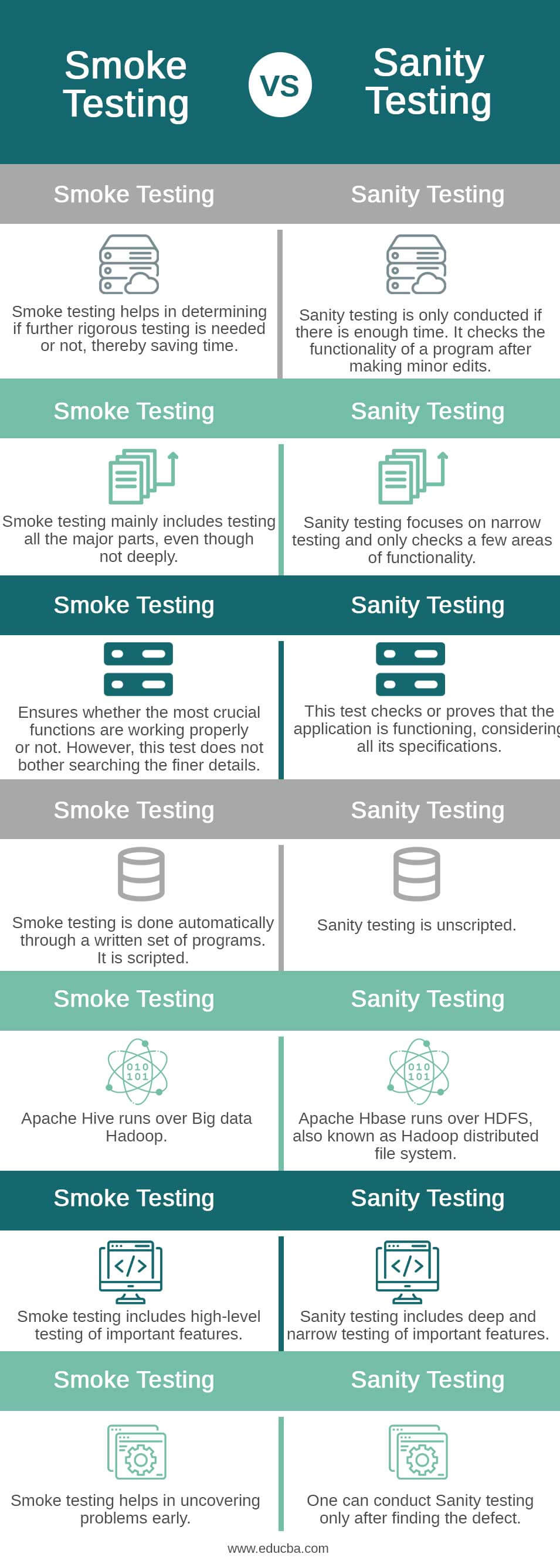Updated March 27, 2023

Introduction
The following article outlines the differences between Smoke Testing vs Sanity Testing. Smoke Testing is performed right before beginning a deeper functional testing process in order to avoid any blockage like environment readiness, application accessibility, database availability, etc. On the other hand, Sanity Testing is performed to test the minor fixes on the application and to make sure the application is good & running with all the vital functionalities up for perfection. Sanity Testing is not necessarily present in all the testing life cycles, while Smoke testing is obligatory for applications involving several system features, integration flow, multiple environment testing, etc.
Types of Smoke Testing
Below are the different types of testing, which are as follows:
- Formal Smoke Testing: Under formal smoke testing, the developer provides the build to the test engineer. The test engineer assigns one tester to each feature of the build and requests them to perform smoke tests. The test leader then analyses all the test results of the build and reports the developer’s end result. These procedures occur officially through proper email chains, thus the name Formal Smoke Testing.
- Informal Smoke Testing: Under this testing method, one performs Smoke testing on the build. However, the test engineers do not make a report of their findings and not necessarily communicate with the lead test engineer.
- Sanity Testing: This is a software technology for running some basic tests on the application. One performs this subset of regression testing when there is enough time to check the features. The method helps check whether all the menus, commands, and other functionalities available in the projects are working fine or not.
Smoke Testing vs Sanity Testing: Head-to-Head Comparison (Infographics)
Below are the top 6 differences between Smoke Testing vs Sanity Testing:
Smoke Testing vs Sanity Testing: Key Differences
- In Smoke testing, only the basic and critical features undergo the test. Smoke testing helps to expose integration and other major problems early in the test cycle.
- Smoke testing also covers most of the major functions and provides a quick test of the software. However, it does not conduct an in-depth test of these programs.
- Smoke testing is a type of general health check for the programs.
- On the other hand, Sanity testing is a subset of regression testing.
- One performs Sanity testing on builds that have already been tested, and a minor change in the code has occurred.
- Sanity testing involves intensive testing of any functionality given in a program.
- One key difference between Sanity testing and Smoke testing is that one performs Sanity testing on mature builds or builds that are entering the market or production.
- Testing teams perform Sanity tests on programs that have already been removed from the testing process.
- Like Smoke testing, if any of the programs fail the Sanity tests, the developer receives it back in order to fix the build.
Smoke Testing vs Sanity Testing Comparison Table
Here are the top 6 comparisons between Smoke Testing vs Sanity Testing:
|
Smoke Testing |
Sanity Testing |
| Smoke testing helps in determining if further rigorous testing is needed or not, thereby saving time. | Sanity testing is only conducted if there is enough time. It checks the functionality of a program after making minor edits. |
| Smoke testing mainly includes testing all the major parts, even though not deeply. | Sanity testing focuses on narrow testing and only checks a few areas of functionality. |
| Ensures whether the most crucial functions are working properly or not. However, this test does not bother searching the finer details. | This test checks or proves that the application is functioning, considering all its specifications. |
| Smoke testing is done automatically through a written set of programs. It is scripted. | Sanity testing is unscripted. |
| Smoke testing includes high-level testing of important features. | Sanity testing includes deep and narrow testing of important features. |
| Smoke testing helps in uncovering problems early. | One can conduct Sanity testing only after finding the defect. |
Conclusion
Smoke testing is a quick and cost-effective approach to detect errors, which one implements at the initial stages of software engineering. One can perform it either manually or through automation, and it helps enhance the application’s quality. Sanity testing, on the other hand, is a surface-level testing that offers a rapid-fire status about the release and planning, and it also helps save time and costs involved in the testing procedure if the build fails. While Smoke and Sanity testing have some similarities, ultimately there are certain key differences that set them apart.
Recommended Articles
Here are some further comparison articles for expanding understanding:

